Change in Material Per Turn

This chart is based on a single playout, and gives a feel for the change in material over the course of a game.
Move by dividing stacks unevenly, connect any two opposite sides to win
(1) Split a stack, and move each part of that stack, (2) Add a new piece. Connect opposite sides to win.
General comments:
Play: Combinatorial
Family: Combinatorial 2015
Mechanism(s): Connection,Stacking
Components: Board
| BGG Entry | Glaisher |
|---|---|
| BGG Rating | 7.06944 |
| #Voters | 18 |
| SD | 1.37388 |
| BGG Weight | 3 |
| #Voters | 1 |
| Year | 2015 |
| User | Rating | Comment |
|---|---|---|
| rayzg | 7 | Nov 2017: Just realized I've been playing this wrong. Stacks can capture stacks of equal height, which means that a huge stack can easily capture an immobile solitary piece right next to it. Must try this again! September 2015: Only one game; unfortunately, I won't be able to convince anyone else to play this again. Highly original movement mechanics yield wonderfully counter-intuitive tactics. For example, a large, powerful stack cannot capture an immobile solitary piece right next it. I prefer my abstract games with almost an overwhelming amount of choices during a turn as this give you an illusion of flexibility -- that you can believe that you can save yourself in any situation. In this game, building towers, and thus movement motions, is of paramount importance. This requires a lot of counter-intuitive lookahead. In addition, it feels like that there are a lot of forced moves (but I might be definitely wrong about this). Beginner players who don't quickly recognize this become stuck, frustrated, and (for non-fans of abstracts) unwilling to try this again. |
| unic | 5.5 | |
| fiddly_bits | N/A | I have bits to play this game, in the actual colors, but not from nestorgames. |
| mrraow | 7 | Very difficult to play well - I have yet to beat the AI. Even with a simple and obvious goal, it's very hard to get your pieces to go where you want them to. |
| Yuki Shimizu | 4 | がんばってー |
| fogus | 5.5 | |
| flowpiux | 7 | |
| at010 | 7 | |
| Thesse1955 | 8 | |
| Dancottrell42 | 9 | Played with the creator. Once the rules are understood it simple in mechanics but complex in variation which is beautiful. I feel like this game will become even more interesting with further plays. |
| kazk | 7 | |
| hiyou | 7 | |
| Shakar | 5 | |
| Arcanio | 8 | |
| tokoro | 9 | |
| zefquaavius | 8 | It's brilliant and interesting, but it can be very difficult to recover once you lose significant ground…. |
| AndrePOR | N/A | Print & Play Edition |
| dexdouglas | N/A | Pnp |
| jmastill | 8 | |
| nestorgames | 9 | |
| jmdsplotter | 6.25 |
| AI | Strong Wins | Draws | Strong Losses | #Games | Strong Win% | p1 Win% | Game Length |
|---|---|---|---|---|---|---|---|
| Random | |||||||
| Grand Unified UCT(U1-T,rSel=s, secs=0.01) | 36 | 0 | 0 | 36 | 100.00 | 61.11 | 40.22 |
| Grand Unified UCT(U1-T,rSel=s, secs=0.03) | 36 | 0 | 10 | 46 | 78.26 | 43.48 | 41.74 |
| Grand Unified UCT(U1-T,rSel=s, secs=0.20) | 36 | 0 | 2 | 38 | 94.74 | 50.00 | 36.66 |
| Grand Unified UCT(U1-T,rSel=s, secs=1.48) | 36 | 0 | 6 | 42 | 85.71 | 35.71 | 37.98 |
Level of Play: Strong beats Weak 60% of the time (lower bound with 90% confidence).
Draw%, p1 win% and game length may give some indication of trends as AI strength increases; but be aware that the AI can introduce bias due to horizon effects, poor heuristics, etc.
| Size (bytes) | 27799 |
|---|---|
| Reference Size | 10577 |
| Ratio | 2.63 |
Ai Ai calculates the size of the implementation, and compares it to the Ai Ai implementation of the simplest possible game (which just fills the board). Note that this estimate may include some graphics and heuristics code as well as the game logic. See the wikipedia entry for more details.
| Playouts per second | 7522.47 (132.94µs/playout) |
|---|---|
| Reference Size | 583703.01 (1.71µs/playout) |
| Ratio (low is good) | 77.59 |
Tavener complexity: the heat generated by playing every possible instance of a game with a perfectly efficient programme. Since this is not possible to calculate, Ai Ai calculates the number of random playouts per second and compares it to the fastest non-trivial Ai Ai game (Connect 4). This ratio gives a practical indication of how complex the game is. Combine this with the computational state space, and you can get an idea of how strong the default (MCTS-based) AI will be.
| 1: Green win % | 48.37±2.12 | Includes draws = 50% |
|---|---|---|
| 2: Red win % | 51.63±2.13 | Includes draws = 50% |
| Draw % | 0.00 | Percentage of games where all players draw. |
| Decisive % | 100.00 | Percentage of games with a single winner. |
| Samples | 2117 | Quantity of logged games played |
Note: that win/loss statistics may vary depending on thinking time (horizon effect, etc.), bad heuristics, bugs, and other factors, so should be taken with a pinch of salt. (Given perfect play, any game of pure skill will always end in the same result.)
Note: Ai Ai differentiates between states where all players draw or win or lose; this is mostly to support cooperative games.
Rotation (Half turn) lost each game as expected.
Reflection (X axis) lost each game as expected.
Reflection (Y axis) lost each game as expected.
Copy last move lost each game as expected.
Mirroring strategies attempt to copy the previous move. On first move, they will attempt to play in the centre. If neither of these are possible, they will pick a random move. Each entry represents a different form of copying; direct copy, reflection in either the X or Y axis, half-turn rotation.
| Game length | 40.89 | |
|---|---|---|
| Branching factor | 28.61 | |
| Complexity | 10^56.58 | Based on game length and branching factor |
| Samples | 2117 | Quantity of logged games played |
| Distinct actions | 3489 | Number of distinct moves (e.g. "e4") regardless of position in game tree |
|---|---|---|
| Killer moves | 36 | A 'killer' move is selected by the AI more than 50% of the time Too many killers to list. |
| Good moves | 2157 | A good move is selected by the AI more than the average |
| Bad moves | 1331 | A bad move is selected by the AI less than the average |
| Terrible moves | 1083 | A terrible move is never selected by the AI Too many terrible moves to list. |
| Samples | 2117 | Quantity of logged games played |

This chart is based on a single playout, and gives a feel for the change in material over the course of a game.

This chart shows the best move value with respect to the active player; the orange line represents the value of doing nothing (null move).
The lead changed on 44% of the game turns. Ai Ai found 3 critical turns (turns with only one good option).
Overall, this playout was 100.00% hot.

This chart shows the relative temperature of all moves each turn. Colour range: black (worst), red, orange(even), yellow, white(best).

Table: branching factor per turn.

This chart is based on a single playout, and gives a feel for the types of moves available over the course of a game.
Red: removal, Black: move, Blue: Add, Grey: pass, Purple: swap sides, Brown: other.
| 0 | 1 | 2 | 3 | 4 | 5 |
|---|---|---|---|---|---|
| 1 | 21 | 1146 | 23967 | 1193136 | 15637326 |
Note: most games do not take board rotation and reflection into consideration.
Multi-part turns could be treated as the same or different depth depending on the implementation.
Counts to depth N include all moves reachable at lower depths.
Inaccuracies may also exist due to hash collisions, but Ai Ai uses 64-bit hashes so these will be a very small fraction of a percentage point.
No solutions found to depth 5.
| Moves | Animation |
|---|---|
| f8 split 1-5 SW,e1,b9 split 1-5 SW,i5,a6 split 2-4 SE | 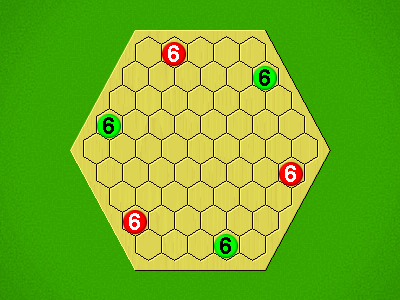 |
| f8 split 2-4 SW,a8,b9 split 1-5 SW,f2 | 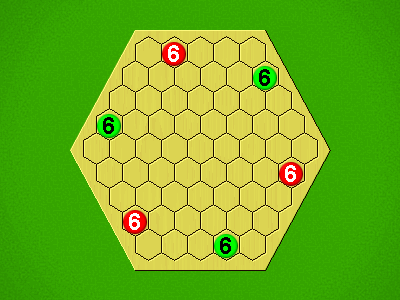 |
| h1 split 1-5 NE,f1,d2 split 2-4 E,d2 | 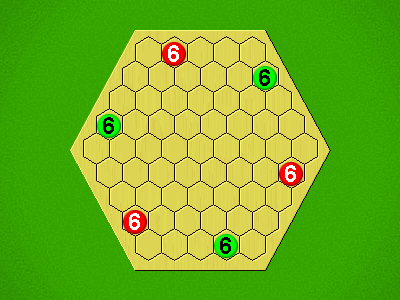 |
| h1 split 1-5 NE,g5,i4 split 1-5 NW,f1 | 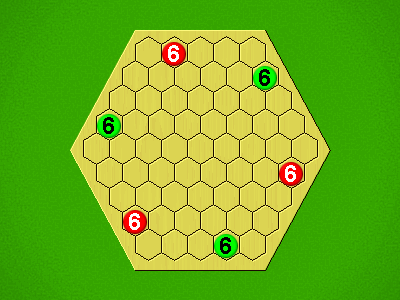 |
| a6 split 1-5 SE,a6,b9 split 2-4 SW,f2 | 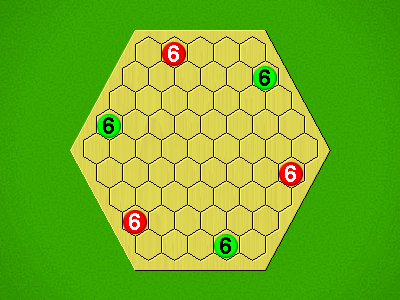 |
| a6 split 1-5 SE,f6,b9 split 2-4 SW,g2 | 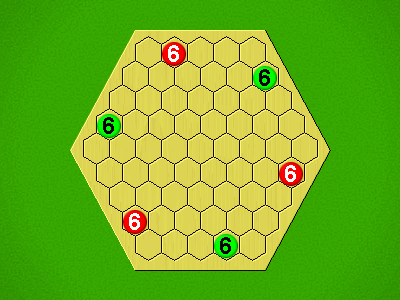 |
| f8 split 1-5 SW,e1,b9 split 1-5 SW,i5 | 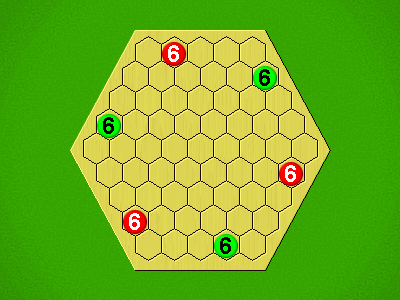 |
| f8 split 2-4 SW,h2,d2 split 2-4 E,i5 | 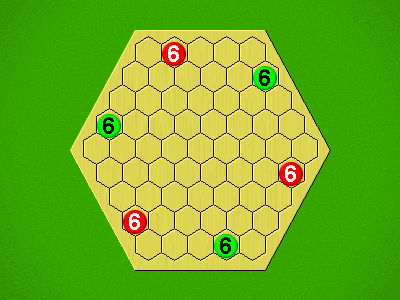 |
| h1 split 1-5 NW,e4,d2 split 1-5 E,c8 | 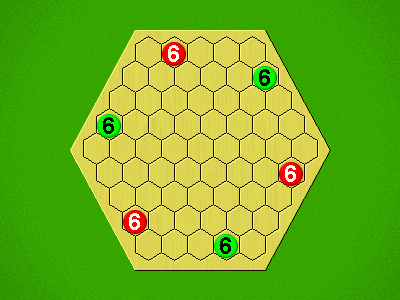 |
| f8 split 1-5 W,i2,b9 split 1-5 SE,e9 | 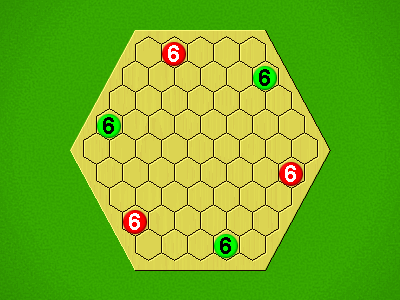 |
| h1 split 1-5 NW,f3,i4 split 2-4 W | 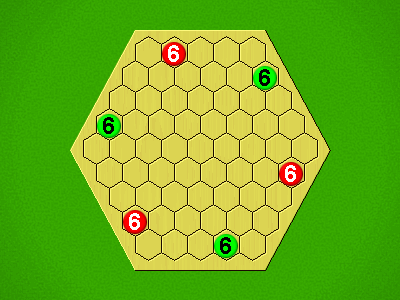 |
| h1 split 1-5 NW,h3,b9 split 1-5 SE | 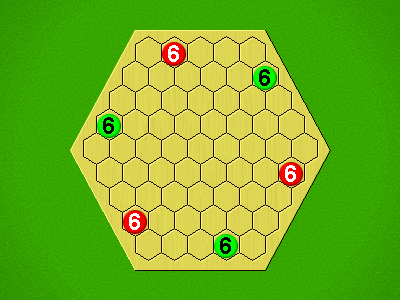 |
| Puzzle | Solution |
|---|---|
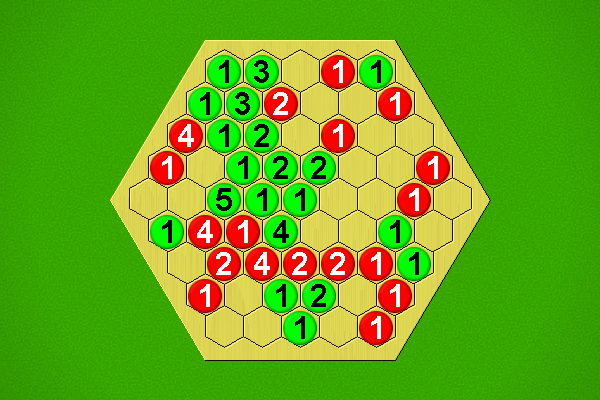 Green to win in 8 moves |
Selection criteria: first move must be unique, and not forced to avoid losing. Beyond that, Puzzles will be rated by the product of [total move]/[best moves] at each step, and the best puzzles selected.